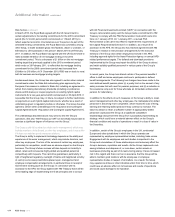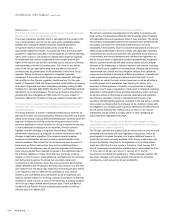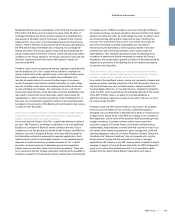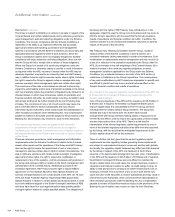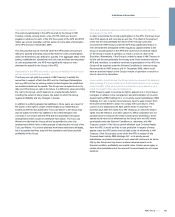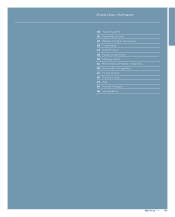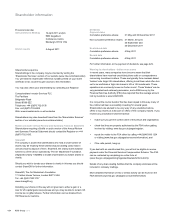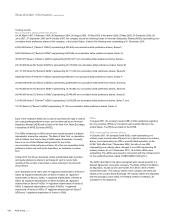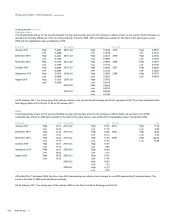RBS 2010 Annual Report Download - page 420
Download and view the complete annual report
Please find page 420 of the 2010 RBS annual report below. You can navigate through the pages in the report by either clicking on the pages listed below, or by using the keyword search tool below to find specific information within the annual report.Risk factors continued
The restructuring plan for RBS Holdings N.V. is complex and may not
realise the anticipated benefits for the Group.
In 2007, the Group acquired an interest, through RFS Holdings B.V., in
ABN AMRO Holding N.V. (which was renamed RBS Holdings N.V. on 1
April 2010). The restructuring plan in place for the integration and
separation of ABN AMRO Holding N.V. into and among the businesses
and operations of the Consortium Members (RBSG, the Dutch State and
Santander) is complex, involving substantial reorganisation of RBS
Holdings N.V.’s operations and legal structure. The restructuring plan is
being implemented and significant elements have been completed within
the planned timescales and the integration of the Group’s businesses
continues.
As part of this reorganisation, on 6 February 2010, the majority of the
businesses of RBS Holdings N.V. acquired by the Dutch State were
legally demerged from the RBS Holdings N.V. businesses acquired by
the Group and were transferred into a newly established company, ABN
AMRO Bank N.V. (formerly named ABN AMRO II N.V.). This company
was transferred to ABN AMRO Group N.V., a company wholly owned by
the Dutch State, on 1 April 2010. Certain assets and liabilities of RBS
Holdings N.V. acquired by the Dutch State were not part of the transfer
which occurred on 1 April 2010 and remain within ABN AMRO Bank N.V.
(now The Royal Bank of Scotland N.V.). These will be transferred to the
Dutch State as soon as possible. In addition, certain assets within RBS
N.V. continue to be under shared ownership by the Consortium Members.
On 31 December 2010, the share capital of RFS Holdings B.V. was
amended, such that approximately 98 per cent. of RFS Holdings B.V.’s
issued share capital is now held by RBSG, with the remainder being held
by Santander and the Dutch State. Ultimately it is expected that RFS
Holdings B.V. will become a wholly-owned subsidiary of the company.
As the Group does not currently own 100 per cent. of RFS Holdings B.V.
and as certain of the assets of RFS Holdings B.V. are owned indirectly by
the Dutch State and Banco Santander S.A. (“Santander”), the Group may
experience delays in implementing the planned integration of the
businesses of RFS Holdings B.V. which are owned by the Group and
such integration may place a strain on management, employee,
operational and financial resources. Any such delays may also restrict the
ability of the Group to realise the expected benefits of the acquisition. In
addition, the Group may not realise the benefits of the acquisition or the
restructuring when expected or to the extent projected. Any of these
events may have an adverse impact on the Group’s financial condition
and results of operations.
The recoverability and regulatory capital treatment of certain deferred tax
assets recognised by the Group depends on the Group's ability to
generate sufficient future taxable profits and there being no adverse
changes to tax legislation, regulatory requirements or accounting
standards.
In accordance with IFRS, the Group has recognised deferred tax assets
on losses available to relieve future profits from tax only to the extent that
it is probable that they will be recovered. The deferred tax assets are
quantified on the basis of current tax legislation and accounting standards
and are subject to change in respect of the future rates of tax or the rules
for computing taxable profits and allowable losses. Failure to generate
sufficient future taxable profits or changes in tax legislation or accounting
standards may reduce the recoverable amount of the recognised
deferred tax assets. In April 2011, the UK Government will commence a
staged reduction in the rate of UK corporation tax from 28 per cent. to 24
per cent. over a four-year period. Such a change in the applicable tax
rate would reduce the recoverable amount of the recognised deferred tax
assets.
There is currently no restriction in respect of deferred tax assets
recognised by the Group for regulatory purposes. Changes in regulatory
capital rules may restrict the amount of deferred tax assets that can be
recognised and such changes could lead to a reduction in the Group’s
Core Tier 1 capital ratio. In particular, on 16 December 2010, the Basel
Committee published the Basel III rules setting out certain changes to
capital requirements (see the risk factor above headed “The Group’s
business performance could be adversely affected if its capital is not
managed effectively or as a result of changes to capital adequacy and
liquidity requirements”). Those rules include a requirement that deferred
tax assets which rely on future profitability of the Group to be realised
may only receive limited recognition when calculating the common equity
component of Tier 1 which therefore limits the amount of deferred tax
assets which can count towards that component of Tier 1 capital. The
implementation of the Basel III reforms will begin on 1 January 2013,
however the restrictions on recognition of deferred tax assets within the
common equity component of Tier 1 are subject to a phased-in deduction
starting on 1 January 2014, to be fully effective by 1 January 2018.
The Group’s participation in the APS is costly and may not produce the
benefits expected and the occurrence of associated risks may have a
material adverse impact on the Group’s business, capital position,
financial condition and results of operations.
On 22 December 2009, the Group acceded to the APS with HM Treasury
acting on behalf of the United Kingdom Government. Under the APS, the
Group purchased credit protection over a portfolio of specified assets and
exposures of RBS and certain members of the Group from HM Treasury
in return for an annual fee. If losses on assets covered by the APS
exceed £60 billion (net of recoveries), HM Treasury will bear 90 per cent.
of further losses. In the event of a further severe or prolonged economic
downturn, which could result in extreme credit losses on the Group’s
asset portfolio, the APS provides additional protection to the Group’s
capital ratios and financial position.
The APS is a unique form of credit protection over a complex range of
diversified assets and exposures (the “Covered Assets”) in a number of
jurisdictions. Owing to the complexity, scale and unique nature of the
APS and the uncertainty resulting from the recent economic recession,
there may be unforeseen issues and risks that are relevant in the context
of the Group’s participation in the APS and in the impact of the APS on
the Group’s business, operations and financial condition. Such issues or
risks may have a material adverse effect on the Group.
Moreover, the Group’s choice of assets or exposures to be covered by
the APS was based on certain predictions and assumptions at the time of
its accession to the APS. There is therefore a risk that the Covered
Assets will not be those with the greatest future losses or with the
greatest need for protection and the Group’s financial condition, income
from operations and the value of any Securities may still suffer due to
further impairments and credit write-downs.
RBS Group 2010418
Additional information continued








